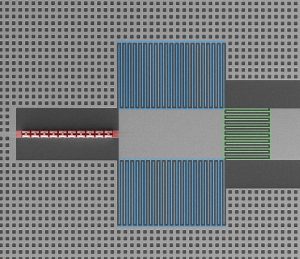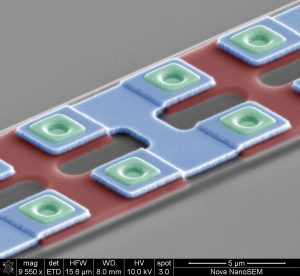Pushing the Quantum Limit in the Search for Dark Matter
Here’s a surprising fact: We don’t know what makes up 80 percent of the matter in the universe. I don’t mean that the matter is made of atoms, and we just don’t know which kind of atoms. What I mean is that four-fifths of the universe appears to be made of something that isn’t atoms at all, or more to the point, it’s not made from any of the fundamental particles that we know of.
Why do we think that this mystery matter exists? The short answer is that Albert Einstein’s theory of gravity, general relativity, has painted us into a corner. When we look through telescopes at stars and galaxies moving through the universe, something we can’t see is causing their motion to bend in a particular way. Einstein’s theory of gravity tells how much of this invisible mass—physicists call it “dark matter”—there must be to bend the trajectory of things we can see.
Faced with a situation like this, we make guesses (hypotheses) that we hope explain our strange observations. A good hypothesis should both be consistent with every known fact and have other detectable consequences. If we look for these other consequences and don’t find them, we discard or revise our hypothesis.
My subfield is quantum physics. In my work, we construct devices that control and measure electricity (current and voltages) as well as quantum mechanics will allow us. Quantum mechanics is a theory that describes the behavior of small things like individual atoms and their constituents, or larger man-made objects like electrical circuits if they are very cold. That’s quite far from cosmology, nuclear physics, and high energy physics, the usual domain of dark matter experiments. But one of the detectable consequences of the axion is that it can create an extraordinarily feeble electrical current oscillating at an unknown frequency somewhere between about 500 megahertz (MHz) and 500 gigahertz (GHz).
And it just so happens that measuring tiny microwave-frequency electrical signals is an experimental challenge that I have a deep affection for.
Indeed, for reasons unrelated to searching for axions, my NIST colleagues and I had constructed devices that measure microwave frequency signals in the range of 4 – 8 GHz. We were interested in understanding both how close a measurement could come to the limit imposed by quantum mechanics, which restricts the precision with which you can measure two complementary properties of a system, such as a particle’s position and direction of travel, at the same time, and to what degree that limit could be circumvented. Coincidentally, these devices had just the right properties to be used in an axion search apparatus called the HAYSTAC that was being constructed at Yale. In 2012, I entered into a collaboration with scientists from Yale, the University of California, Berkeley, and Lawrence Livermore National Laboratory to search for axions. Our role was to build the devices that would perform the delicate measurement of electrical currents at the quantum limit.
Even so, the time required to search the whole frequency range is prohibitively long. In order to speed up this search, it will be necessary to somehow beat the limitations on electrical measurement imposed by quantum mechanics. Fortunately, because we know that quantum mechanics only limits certain types of simultaneous knowledge, in this case, the height of a wave’s peak (amplitude) and the time that the peak occurs (phase), we can modify our devices so that they only detect the amplitude or the phase of the oscillating current, but not both at the same time. Quantum mechanics doesn’t impose a limit on the sensitivity of a measurement of just one of these two quantities. My future work in the axion collaboration will be to deploy these beyond-quantum-limited measurements in the search apparatus.
When we can routinely detect electrical currents better than the quantum limit, we will begin observing many results that we never could have anticipated and potentially open the door to new physics—a very exciting prospect. I certainly never expected to find myself working in a nuclear physics collaboration, but in my line of work, it pays to keep an open mind and expect the unexpected!
via Konrad Lehnert
Why do we think that this mystery matter exists? The short answer is that Albert Einstein’s theory of gravity, general relativity, has painted us into a corner. When we look through telescopes at stars and galaxies moving through the universe, something we can’t see is causing their motion to bend in a particular way. Einstein’s theory of gravity tells how much of this invisible mass—physicists call it “dark matter”—there must be to bend the trajectory of things we can see.
Faced with a situation like this, we make guesses (hypotheses) that we hope explain our strange observations. A good hypothesis should both be consistent with every known fact and have other detectable consequences. If we look for these other consequences and don’t find them, we discard or revise our hypothesis.
My subfield is quantum physics. In my work, we construct devices that control and measure electricity (current and voltages) as well as quantum mechanics will allow us. Quantum mechanics is a theory that describes the behavior of small things like individual atoms and their constituents, or larger man-made objects like electrical circuits if they are very cold. That’s quite far from cosmology, nuclear physics, and high energy physics, the usual domain of dark matter experiments. But one of the detectable consequences of the axion is that it can create an extraordinarily feeble electrical current oscillating at an unknown frequency somewhere between about 500 megahertz (MHz) and 500 gigahertz (GHz).
And it just so happens that measuring tiny microwave-frequency electrical signals is an experimental challenge that I have a deep affection for.
Indeed, for reasons unrelated to searching for axions, my NIST colleagues and I had constructed devices that measure microwave frequency signals in the range of 4 – 8 GHz. We were interested in understanding both how close a measurement could come to the limit imposed by quantum mechanics, which restricts the precision with which you can measure two complementary properties of a system, such as a particle’s position and direction of travel, at the same time, and to what degree that limit could be circumvented. Coincidentally, these devices had just the right properties to be used in an axion search apparatus called the HAYSTAC that was being constructed at Yale. In 2012, I entered into a collaboration with scientists from Yale, the University of California, Berkeley, and Lawrence Livermore National Laboratory to search for axions. Our role was to build the devices that would perform the delicate measurement of electrical currents at the quantum limit.
Even so, the time required to search the whole frequency range is prohibitively long. In order to speed up this search, it will be necessary to somehow beat the limitations on electrical measurement imposed by quantum mechanics. Fortunately, because we know that quantum mechanics only limits certain types of simultaneous knowledge, in this case, the height of a wave’s peak (amplitude) and the time that the peak occurs (phase), we can modify our devices so that they only detect the amplitude or the phase of the oscillating current, but not both at the same time. Quantum mechanics doesn’t impose a limit on the sensitivity of a measurement of just one of these two quantities. My future work in the axion collaboration will be to deploy these beyond-quantum-limited measurements in the search apparatus.
When we can routinely detect electrical currents better than the quantum limit, we will begin observing many results that we never could have anticipated and potentially open the door to new physics—a very exciting prospect. I certainly never expected to find myself working in a nuclear physics collaboration, but in my line of work, it pays to keep an open mind and expect the unexpected!
via Konrad Lehnert




